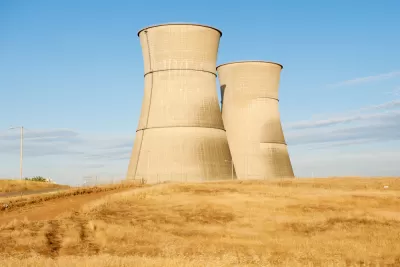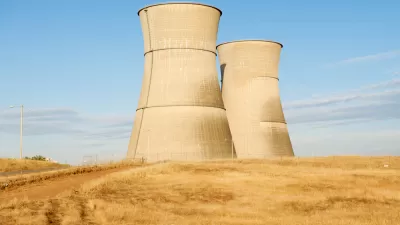The Infrastructure Investment and Jobs Act includes $6 billion to create a credit program to extend the life of existing nuclear power plants, the largest source of carbon-free energy in the nation. The first deadline to bid for credits is May 19.

“While the Infrastructure Bill is wide-reaching, it includes a number of nuclear energy-related provisions, including support for keeping nuclear power plants facing economic hardship operating and funding for the Department of Energy's Advanced Reactor Demonstration Program,” write Amy Roma & Stephanie Fishman for the law firm, Hogan Lovells, on November 15, 2021, the day President Joe Biden signed the bill.
An example of a projected funded through that demonstration program is TerraPower's (a Bill Gates' startup) Natrium reactor that will replace a coal plant in Kemmerer, Wyoming (see AP article, Jan. 18, and the Planetizen post when it received the funding from the Energy Department last November shortly after the Infrastructure Investment and Jobs Act became law.
Civil Nuclear Credit Program
In February, the Energy Department established a $6 billion Civil Nuclear Credit Program to tackle the first issue – extending the life of existing nuclear plants, particularly those that are facing imminent closure largely for economic reasons, by “allowing owners or operators of commercial U.S. reactors to apply for certification and competitively bid on credits to help support their continued operations,” according to their press release on Feb. 11.
“I appreciate that the Department of Energy is taking this first crucial step to implement the Civil Nuclear Credit Program authorized and funded under the Bipartisan Infrastructure Law,” said U.S. Senator Joe Manchin (D-WV), Chairman of the Senate Energy and Natural Resources Committee.
“Ensuring the continued operation of our domestic nuclear fleet is essential to achieving our emission reduction goals while also maintaining reliability. I fought for the inclusion of this critical program to prevent further premature closures of nuclear power plants and to maintain high-paying jobs in communities across America.”
Let the Bidding Begin
Two months later, the Energy Department announced that it was seeking applications for the new program.
“The guidance published today directs owners or operators of nuclear power reactors that are expected to shut down due to economic circumstances on how to apply for funding to avoid premature closure,” states their press release on April 19.
The credit program “aims to give a financial lifeline to plants facing imminent shutdown for economic reasons,” writes Evan Halper for The Washington Post (source article) on April 19.
The first round of credits are set aside for plants that have already announced plans to close. There are at least two such operations in the United States: Diablo Canyon in California and Palisades in [Covert] Michigan.
But the nation still has a sizable nuclear fleet, with 55 plants in 28 states. Most of them have at least two reactors. Many of them have fallen under financial hardship as the prices of renewable energy and natural gas dropped in recent years.
The Office of Nuclear Energy has set May 19 as the deadline for applications for the first cycle of civil nuclear credit awards.
Final words go to the secretary of the Department of Energy, Jennifer Granholm (see related post) as stated on April 19.
“U. S. nuclear power plants contribute more than half of our carbon-free electricity, and President Biden is committed to keeping these plants active to reach our clean energy goals.
“We’re using every tool available to get this country powered by clean energy by 2035, and that includes prioritizing our existing nuclear fleet to allow for continued emissions-free electricity generation and economic stability for the communities leading this important work.”
Related posts:
- Biden Commits Federal Government to Carbon Neutrality, December 8, 2021
- Key Details of the $1.2 Trillion Federal Infrastructure Bill, November 15, 2021
- Opinion: Replacing Nuclear Plants Amounts to 'Treadmill Decarbonization,' July 25, 2021
- Trump Rebuffed by Federal Energy Commissioners on Coal and Nuclear Power Bailout, June 18, 2018
- Indian Point Nuclear Plant to Shut Down by 2021, January 11, 2017
- The Only Remaining Nuclear Power Plant in California Will Close, June 23, 2016
FULL STORY: Biden administration launches $6 billion nuclear plant bailout

Planetizen Federal Action Tracker
A weekly monitor of how Trump’s orders and actions are impacting planners and planning in America.

Map: Where Senate Republicans Want to Sell Your Public Lands
For public land advocates, the Senate Republicans’ proposal to sell millions of acres of public land in the West is “the biggest fight of their careers.”

Restaurant Patios Were a Pandemic Win — Why Were They so Hard to Keep?
Social distancing requirements and changes in travel patterns prompted cities to pilot new uses for street and sidewalk space. Then it got complicated.

California Homeless Arrests, Citations Spike After Ruling
An investigation reveals that anti-homeless actions increased up to 500% after Grants Pass v. Johnson — even in cities claiming no policy change.

Albuquerque Route 66 Motels Become Affordable Housing
A $4 million city fund is incentivizing developers to breathe new life into derelict midcentury motels.

DC Area County Eliminates Bus Fares
Montgomery County joins a growing trend of making transit free.
Urban Design for Planners 1: Software Tools
This six-course series explores essential urban design concepts using open source software and equips planners with the tools they need to participate fully in the urban design process.
Planning for Universal Design
Learn the tools for implementing Universal Design in planning regulations.
Heyer Gruel & Associates PA
JM Goldson LLC
Custer County Colorado
City of Camden Redevelopment Agency
City of Astoria
Transportation Research & Education Center (TREC) at Portland State University
Camden Redevelopment Agency
City of Claremont
Municipality of Princeton (NJ)




























